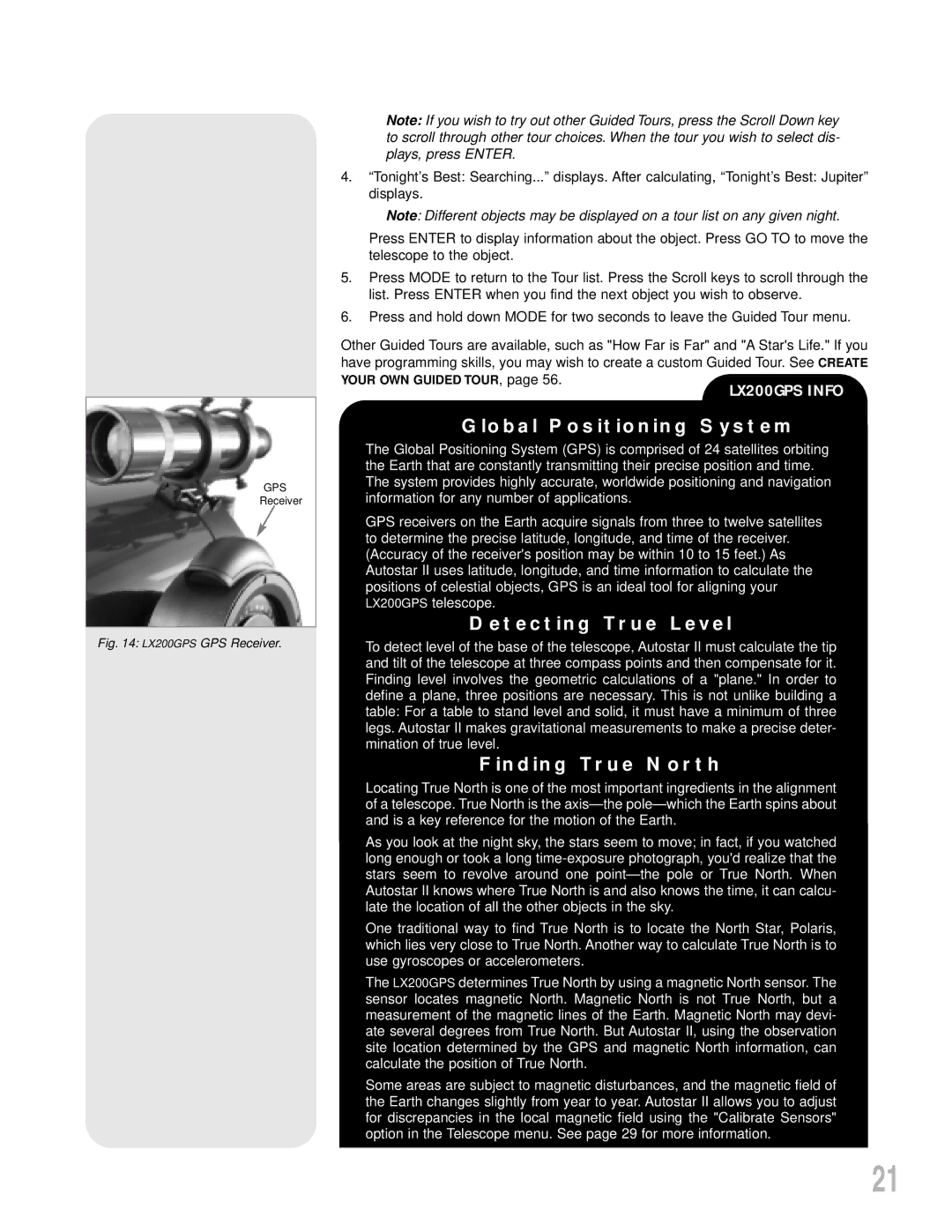
GPS
Receiver
Fig. 14: LX200GPS GPS Receiver.
Note: If you wish to try out other Guided Tours, press the Scroll Down key to scroll through other tour choices. When the tour you wish to select dis- plays, press ENTER.
4.“Tonight’s Best: Searching...” displays. After calculating, “Tonight’s Best: Jupiter” displays.
Note: Different objects may be displayed on a tour list on any given night.
Press ENTER to display information about the object. Press GO TO to move the telescope to the object.
5.Press MODE to return to the Tour list. Press the Scroll keys to scroll through the list. Press ENTER when you find the next object you wish to observe.
6.Press and hold down MODE for two seconds to leave the Guided Tour menu.
Other Guided Tours are available, such as "How Far is Far" and "A Star's Life." If you have programming skills, you may wish to create a custom Guided Tour. See CREATE YOUR OWN GUIDED TOUR, page 56.
The Global Positioning System
The Global Positioning System (GPS) is comprised of 24 satellites orbiting the Earth that are constantly transmitting their precise position and time. The system provides highly accurate, worldwide positioning and navigation information for any number of applications.
GPS receivers on the Earth acquire signals from three to twelve satellites to determine the precise latitude, longitude, and time of the receiver. (Accuracy of the receiver's position may be within 10 to 15 feet.) As Autostar II uses latitude, longitude, and time information to calculate the positions of celestial objects, GPS is an ideal tool for aligning your LX200GPS telescope.
Detecting True Level
To detect level of the base of the telescope, Autostar II must calculate the tip and tilt of the telescope at three compass points and then compensate for it. Finding level involves the geometric calculations of a "plane." In order to define a plane, three positions are necessary. This is not unlike building a table: For a table to stand level and solid, it must have a minimum of three legs. Autostar II makes gravitational measurements to make a precise deter- mination of true level.
Finding True North
Locating True North is one of the most important ingredients in the alignment of a telescope. True North is the
As you look at the night sky, the stars seem to move; in fact, if you watched long enough or took a long
One traditional way to find True North is to locate the North Star, Polaris, which lies very close to True North. Another way to calculate True North is to use gyroscopes or accelerometers.
The LX200GPS determines True North by using a magnetic North sensor. The sensor locates magnetic North. Magnetic North is not True North, but a measurement of the magnetic lines of the Earth. Magnetic North may devi- ate several degrees from True North. But Autostar II, using the observation site location determined by the GPS and magnetic North information, can calculate the position of True North.
Some areas are subject to magnetic disturbances, and the magnetic field of the Earth changes slightly from year to year. Autostar II allows you to adjust for discrepancies in the local magnetic field using the "Calibrate Sensors" option in the Telescope menu. See page 29 for more information.
21
